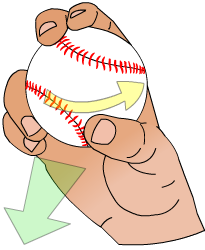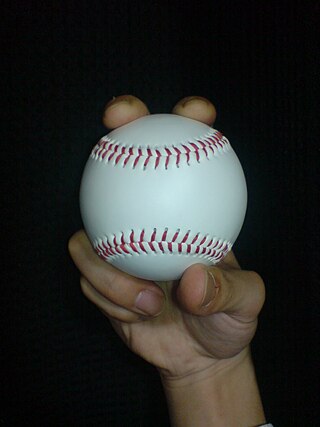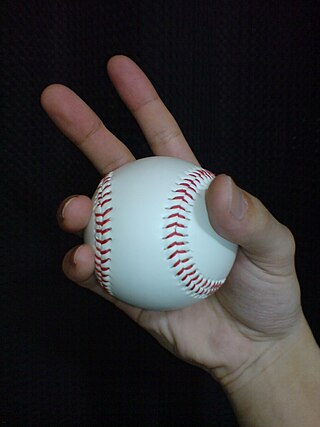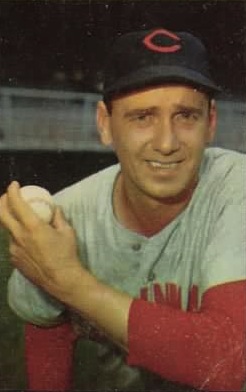Related Research Articles

Éric Serge Gagné is a Canadian former professional baseball pitcher who played 10 seasons in Major League Baseball (MLB), most notably for the Los Angeles Dodgers. After signing with the Dodgers as a free agent in 1995, Gagné began his career as a starting pitcher. After he struggled in that role, the Dodgers converted Gagné from a starter to a reliever, where for three years (2002–2004) he was statistically the most outstanding closer in the game, winning the Cy Young Award in 2003. During that period, he set a major league record by converting 84 consecutive save opportunities. The phrase "Game Over" was heavily used by the Dodgers and the media in connection with his appearances to finish close games.

The fastball is the most common type of pitch thrown by pitchers in baseball and softball. "Power pitchers," such as former American major leaguers Nolan Ryan and Roger Clemens, rely on speed to prevent the ball from being hit and have thrown fastballs at speeds of 95–105 miles per hour (153–169 km/h) (officially) and up to 108.1 miles per hour (174.0 km/h) (unofficially). Pitchers who throw more slowly can put movement on the ball, or throw it on the outside of home plate where batters can't easily reach it.

The forkball is a type of pitch in baseball. Related to the split-finger fastball, the forkball is held between the first two fingers and thrown hard, snapping the wrist.

In baseball, a slider is a breaking ball pitch that tails laterally and down through the batter's hitting zone. It is thrown at a speed that is lower than a fastball, but higher than the pitcher's curveball.

A changeup is a type of pitch in baseball and fastpitch softball.

A split-finger fastball or splitter is an off-speed pitch in baseball that looks to the batter like a fastball until it drops suddenly. Derived from the forkball, it is so named because the pitcher puts the index and middle finger on different sides of the ball.

In baseball, a starting pitcher or starter is the first pitcher in the game for each team. A pitcher is credited with a game started if they throw the first pitch to the opponent's first batter of a game. Starting pitchers are expected to pitch for a significant portion of the game, although their ability to do this depends on many factors, including effectiveness, stamina, health, and strategy.
A screwball is a baseball and fastpitch softball pitch that is thrown so as to break in the opposite direction of a slider or curveball. Depending on the pitcher's arm angle, the ball may also have a sinking action. The pitch is sometimes known as the scroogie or airbender.

In baseball, the pitch is the act of throwing the baseball toward home plate to start a play. The term comes from the Knickerbocker Rules. Originally, the ball had to be thrown underhand, much like "pitching in horseshoes". Overhand pitching was not allowed in baseball until 1884.

A two-seam fastball is a pitch in baseball and softball. It is a variant of the straight fastball. The pitch has the speed of a fastball and can also include late-breaking action caused by varying the pressure of the index and middle fingers on the ball.

In baseball, a circle changeup or circle change is a pitch thrown with a grip that includes a circle formation, hence the name circle changeup. The circle is formed by making a circle with the index finger, holding the thumb at the bottom of the ball parallel to the middle finger and holding the ball far out in the hand. The ball is thrown turning the palm out.

In baseball, the palmball pitch is a type of changeup. It requires placing the baseball tightly in the palm or held between the thumb and ring finger and then throwing it as if throwing a fastball. This takes some of the velocity off the pitch, intending to make the batter swing before the ball reaches the plate.

In baseball, a cut fastball or cutter is a type of fastball that breaks toward the pitcher's glove-hand side, as it reaches home plate. This pitch is somewhere between a slider and a four-seam fastball, as it is usually thrown faster than a slider but with more movement than a typical fastball. Some pitchers use a cutter to prevent hitters from expecting their regular fastballs. A common technique for throwing a cutter is to use a four-seam fastball grip with the baseball set slightly off center in the hand. A batter hitting a cutter pitch often achieves only soft contact and an easy out due to the pitch's movement keeping the ball away from the bat's sweet spot. The cutter is typically 2–5 mph slower than a pitcher's four-seam fastball. In 2010, the average pitch classified as a cutter by PITCHf/x thrown by a right-handed pitcher was 88.6 mph; the average two-seamer was 90.97 mph.

In Major League history, the term knuckle curve or knuckle curveball has been used to describe three entirely different pitches. All are unrelated to the similar sounding knuckleball.
In baseball, an off-speed pitch is a pitch thrown at a slower speed than a fastball. Breaking balls and changeups are the two most common types of off-speed pitches. Very slow pitches which require the batter to provide most of the power on contact through bat speed are known as "junk" and include the knuckleball and the Eephus pitch, a sort of extreme changeup. The specific goals of off-speed pitches may vary, but in general they are used to disrupt the batter's timing, thereby lessening his chances of hitting the ball solidly or at all. Virtually all professional pitchers have at least one off-speed pitch in their repertoire. Despite the fact that most of these pitches break in some way, batters are sometimes able to anticipate them due to hints that the pitcher gives, such as changes in arm angle, arm speed, or placement of fingers.

Roy Edward Oswalt is an American former professional baseball pitcher. Oswalt played for the majority of his Major League Baseball (MLB) career with the Houston Astros. He also played for the Philadelphia Phillies, Texas Rangers, and Colorado Rockies.

A gyroball is a type of baseball pitch used primarily by players in Japan. It is thrown with a spiral-like spin, so that there is no Magnus force on the ball as it arrives at home plate. The gyroball is sometimes confused with the shuuto, another pitch used in Japan.

Kenneth David Raffensberger was an American starting pitcher in Major League Baseball (MLB). From 1939 through 1954, he played for the St. Louis Cardinals (1939), Chicago Cubs (1940–41), Philadelphia Phillies (1943–47), and Cincinnati Reds/Redlegs (1947–54). Raffensberger batted right-handed and threw left-handed.

Ubaldo Jiménez García is a Dominican-American former professional baseball pitcher. He played in Major League Baseball (MLB) for the Colorado Rockies, Cleveland Indians and Baltimore Orioles. Jiménez was an MLB All-Star in 2010. That year, he pitched the first no-hitter in Rockies' franchise history.
The fosh, fosh ball, or fosh change is a seldom used pitch in Major League Baseball described as "a cross between a split-fingered pitch and a straight change-up". It is designed to fool a batter expecting a fastball to have to contend with a slower pitch. The pitch has a grip like a fastball, but the index and middle fingers are spread slightly across the baseball, and the ring and little finger wrap around the side of the ball. If thrown properly, it has characteristics like a breaking change-up or an off-speed split-finger fastball.
References
- ↑ Hughes, Phil (2 February 2008). "Ian's Answers ..." The Phil Hughes Weblog. Retrieved 2010-04-26.
- ↑ "Keep an eye on Atlanta Braves pitcher John Gant". The Telegraph. 26 March 2016. Retrieved 2016-06-18.
- ↑ "Tomlin's change of pace keeping Pirates in step". The Pittsburgh Press. 7 August 1991.
He calls it a changeup. His teammates call it a Vulcan changeup. New York Mets hitters were calling it things that cannot be printed after he sent them cussing back to the dugout time after time last night.
- ↑ "Vulcan grip changed RP Joe Nelson's career". Boston Herald. Herald Media. 20 February 2010. Retrieved 2010-04-26.
The Vulcan, as it's known, is the grip Nelson uses for his changeup, and he jokes that it has kept him in professional baseball for 14 years.
- ↑ "Tampa Bay Rays Tales: Star Trek fan Joe Nelson hopes to pitch long and prosper". St. Petersburg Times. 3 May 2009. Archived from the original on 2009-06-07. Retrieved 2010-04-26.
- ↑ Law, Keith (12 September 2007). "Good fit for Gagne, Brewers". Scouts Inc., ESPN Internet Ventures. Retrieved 2010-04-26.
- ↑ "Phillies' Oswalt tells gripping story of learning to like the changeup". Philadelphia Daily News. 17 September 2010. Retrieved 2010-09-17.
- ↑ "Joe Nelson". They Said It. Sports Illustrated, Time Inc. 2009-05-18. Retrieved 2010-04-26.